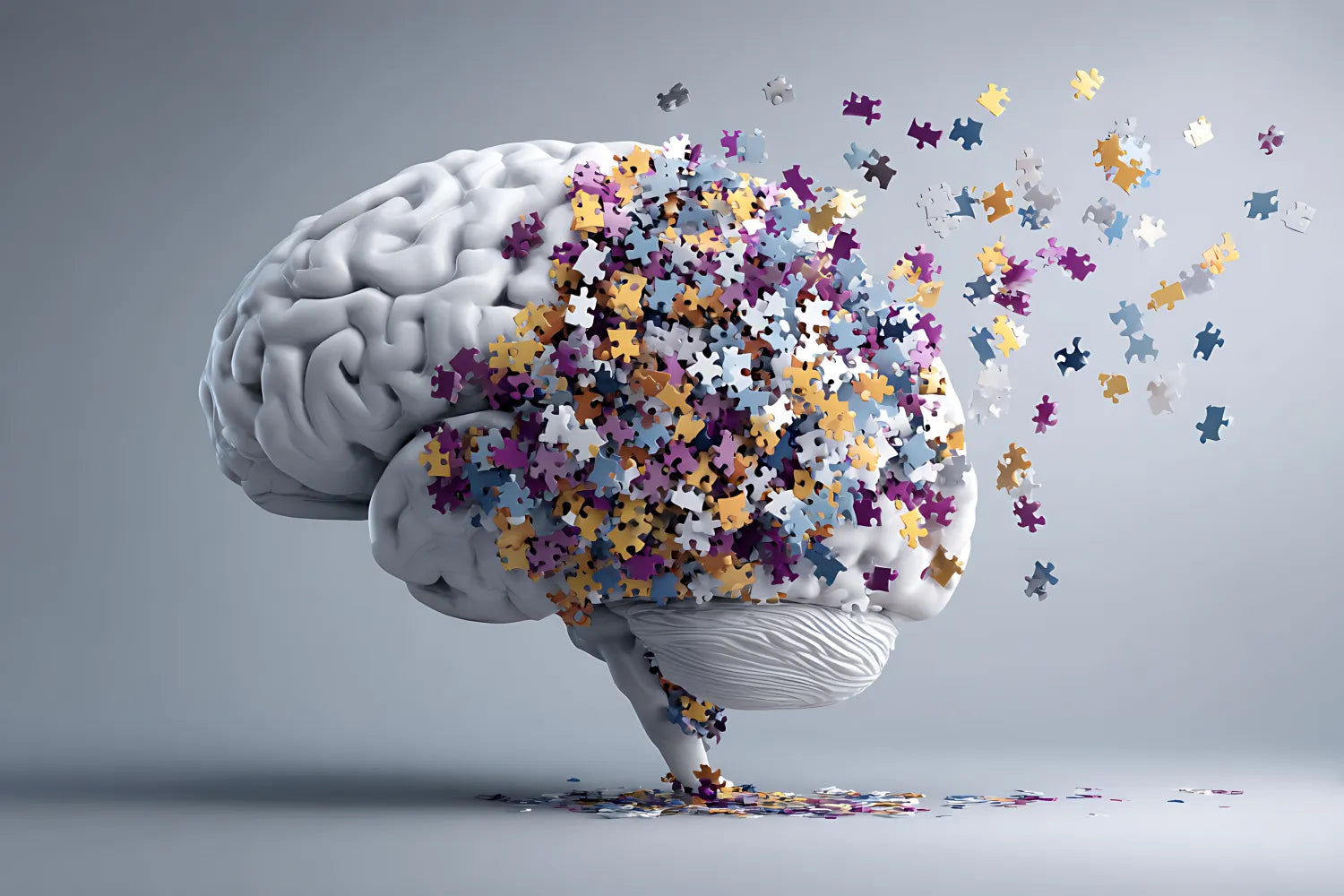
Dr. Eric Venn-Watson’s Highlights
-
- The endocannabinoid system regulates numerous functions in our body, including memory and cognition.
- Our body makes endocannabinoids, and they directly stimulate the receptors of the endocannabinoid system.
- Taking a supplement like fatty15 can help your body produce more of a particular endocannabinoid capable of stimulating both types of receptors in the endocannabinoid system.
Having trouble remembering simple bits of information (like names or events) can be frustrating. As we age, our brains seem flooded with all the information we don’t need to recall. We often find ourselves making lists and setting reminders just so we can manage to keep up with life.
There’s an entire system in the body that helps regulate memory and cognition called the endocannabinoid system. Together, we’ll learn what it is, how it works, and what we can do to help support it and our memories.
What Is the Endocannabinoid System?
The endocannabinoid system (ECS) is a complex system of receptors located throughout our brains and bodies. These receptors gather information and help the body maintain balance.
The ECS is directly involved with processes like:
- Mood
- Appetite
- Sleep
- Blood sugar
- Metabolism
- Thermoregulation
- Memory and cognition
The system comprises two different types of receptors, CB1 receptors and CB2 receptors. Cannabinoids are compounds that can bind to these receptors and stimulate them, resulting in necessary changes needed to keep the body in a state of balance or homeostasis.
ECS and Memory
The ECS is directly involved with our memory, specifically due to the receptors located in the hippocampus, where specific memories are held. Studies have shown that the receptors located here can directly impact how we form and keep memories.
- CB1 receptors. These receptors are involved with object recognition, fear conditioning, learning processes, and the acquisition of memories.
- CB2 receptors. The role of these receptors in memory-making is somewhat unclear, but we know that CB2 receptors are involved with memory consolidation.
Interestingly, stimulation of these receptors can both improve and impair memory. The deciding factor is the cannabinoid compound used and the amount. We want to increase the compounds that help us build, retain, and recall memories, and decrease the compounds that cause our memory and cognition to perform poorly.
Thankfully, it’s pretty easy to learn which compounds work and which don’t.
Cannabinoids and Memory
There are three different types of cannabinoids: plant-based cannabinoids, synthetic cannabinoids, and endocannabinoids.
- Plant-based cannabinoids include compounds in the Cannabis sativa plant, like CBD and THC. THC is known to have a negative impact on memory, causing short-term memory loss when used.
THC is thought to also interfere with executive function, motor skills, and working memory. CBD doesn’t produce these same results, but it does have the effect of reducing fear-based responses, which can produce a calming effect.
- Synthetic cannabinoids are a class of cannabinoids that are created in a lab. These are sometimes used therapeutically to soothe symptoms like upset stomach and physical discomfort. In terms of memory and cognition, these types of drugs may also interfere with short-term memory recall.
- Endocannabinoids are made by your body and support your ability to create and recall memories. The two most studied endocannabinoids are anandamide (AEA) and 2-AG.
Anandamide
Anandamide, also known as AEA (N-arachidonoylethanolamine), is a partially-acting endocannabinoid. Studies have shown that stimulation of the CB1 receptors with anandamide can reduce fear memories, which may help with the symptoms of PTSD. Researchers also found that stimulation of the CB1 receptors can improve memory and make it easier for subjects to recall memories more quickly.
Anandamide is only capable of stimulating CB1 receptors, which means it isn’t “fully acting” and is limited in its therapeutic use to processes that are governed by CB1 receptors only.
2-AG
2-AG (2-arachidonoylglycerol) is a fully-acting endocannabinoid, which means it can stimulate both CB1 and CB2 receptors. Scientists have discovered that 2-AG stimulation on receptors in the hippocampus directly impacts our ability to store and recall long-term memories.
We can support healthy memory function by ensuring our bodies are producing plenty of endocannabinoids and learning if they can make new ones.
Until now, we’ve only known about two (AEA and 2-AG). Now, we have access to a newly discovered endocannabinoid that is fully acting, called pentadecanoylcarnitine, or PDC.
PDC: The New Kid on the Block
Like 2-AG, PDC (pentadecanoylcarnitine) is fully acting, which means it can bind to both CB1 and CB2 receptors. This is big news because it means we now have another way to stimulate both types of receptors for therapeutic use.
Unlike 2-AG, which metabolizes very quickly, PDC stays in the body longer, giving it more opportunity to work. PDC also decreases pro-inflammatory cytokines in systems like autoimmune, cardiovascular, neoplastic, pulmonary, and skin. This means that having enough PDC circulating in our system supports the healthy functioning of these systems.
This makes PDC even more important, and ensuring our body is making enough can be tough. Here’s why.
How PDC Is Made
All endocannabinoids start as fatty acids. Our bodies synthesize these fatty acids and change them into endocannabinoids. To make AEA and 2-AG, the body uses arachidonic acid, a polyunsaturated omega-6. To make PDC, the body needs pentadecanoic acid or C15:0.
C15:0 is an odd-chained, saturated fatty acid that has been recently recognized as the first essential fatty acid to have been discovered since the omegas (more than 90 years ago). Although we have heard that all saturated fats are bad for us, science now supports that that is not the case.
C15:0 is an odd-chain saturated fatty acid, which has recently been identified as an essential fatty acid. An essential fatty acid is one that our bodies cannot make, that we must get through our diet. Science supports that higher levels of C15:0 is associated with better metabolic, immune, heart, and liver health.
What Foods Contain C15:0?
C150 is found primarily in whole dairy products like whole milk and butter, however increasing your intake of these foods may not be the best solution because it would mean increasing your calories and levels of the pro-inflammatory, even-chain saturated fats.
A solution? Fatty15.
Elevate your cells. Elevate your self.
Buy NowFatty15: The Precursor to PDC
It can be difficult to obtain the C15:0 your body needs to remain healthy through your diet alone, but fatty15 makes it easy. Fatty15 contains just one ingredient, FA15™, the pure, vegan-friendly, award-winning version of C15:0. Just 100 mg daily (the amount in every fatty15 capsule) is enough to restore your circulating levels of C15:0 and provide your body the necessary building blocks to make the fully acting endocannabinoid PDC.*
More PDC can help support healthy memory and cognition, but fatty15 also benefits your body in other ways, like:*
- Helping protect your cells. Fatty15 is a sturdy fatty acid that integrates itself into cell membranes and strengthens them, protecting your cells against damage.
- Improving mitochondrial function. The powerhouses of your cells get a boost from fatty15, which has been shown to improve mitochondrial function by 45 percent.
Most surprisingly, research shows that C15:0 is better, broader, and safer than the most effective form of omega-3.* Three cheers for finally ditching those smelly fish oil capsules!
- Better. In studies, fatty15 was shown to have 36 clinically relevant benefits. Omega-3 only had 10.
- Broader. Out of 12 cell types studied, fatty15 was able to repair 10 of them and stopped bad cells from proliferating. Omega-3 only safely repaired four cell types.
-
Safer. Fatty15 was safe for our 12 cell types, but omega-3 was actually toxic at higher doses to certain types of cells, including lung and blood vessel cells.
In addition, omega-3s are oils, which can go rancid on store shelves, even before you bring them home. On the contrary, fatty15 contains the pure powder C15:0 that is not subject to peroxidation or rancidity. That means, unlike omega-3 fish oil pills, fatty15 is stable, safe, and ready to promote your long term health and wellness.
Remember: Fatty15
Most of us could use a little help remembering information like names, events, or why we walked into a certain room. Now, we’ve got a solution.
Fatty15 is the once-a-day supplement that can help support your body’s ability to make PDC, a fully-acting endocannabinoid that can support your cognitive health.*
A suggestion? Go ahead and grab your fatty15 (before you forget).
Sources:

Eric Venn-Watson M.D.
CEO, Co-Founder
Senior Scientist, Co-Founder
Eric is a physician, U.S. Navy veteran, and Co-founder and COO of Seraphina Therapeutics. Eric served over 25 years as a Navy and Marine Corps physician, working with the special forces community to improve their health and fitness. Seraphina Therapeutics is a health and wellness company dedicated to advancing global health through the discovery of essential fatty acids and micronutrient therapeutics.
You May Also Like...
When Does Cognitive Decline Start?
Almost everyone will experience some cognitive decline in their lifetime. Learn which decade is most closely associated with thinking trouble.
List of Cognitive Changes in the Elderly as They Age
Are you wondering where your keys are? Not being able to find them could be due to cognitive changes in your brain as you age.


